Financial Analysis and Corporate Management Report: Paltel Company
VerifiedAdded on 2022/09/05
|17
|3614
|15
Report
AI Summary
This report provides a detailed analysis of the Palestine Telecommunication Company's (Paltel) corporate finance strategies. It begins with an introduction to corporate finance, outlining the process of finding financial needs and sourcing finance to maximize shareholder wealth. The report analyzes Paltel's financial and operating performance, including its financial position based on the 2018 annual report. It examines the company's capital structure, debt-to-equity ratio, and dividend policies over the past few years, highlighting the impact on its financial performance. The report also assesses Paltel's investment opportunities, financing needs, and the application of various investment appraisal techniques such as Net Present Value (NPV), Internal Rate of Return (IRR), Discounted Payback, Accounting Rate of Return (ARR), and Profitability Index (PI) to aid in investment decision-making. Finally, it concludes with an overview of the company's strengths and weaknesses, recommending an investment strategy for future growth. The report also includes a discussion on the cost of equity and debt, as well as suggestions for financing decisions, such as raising capital through debt or equity, and their respective impacts on the company's financial position and shareholder wealth.
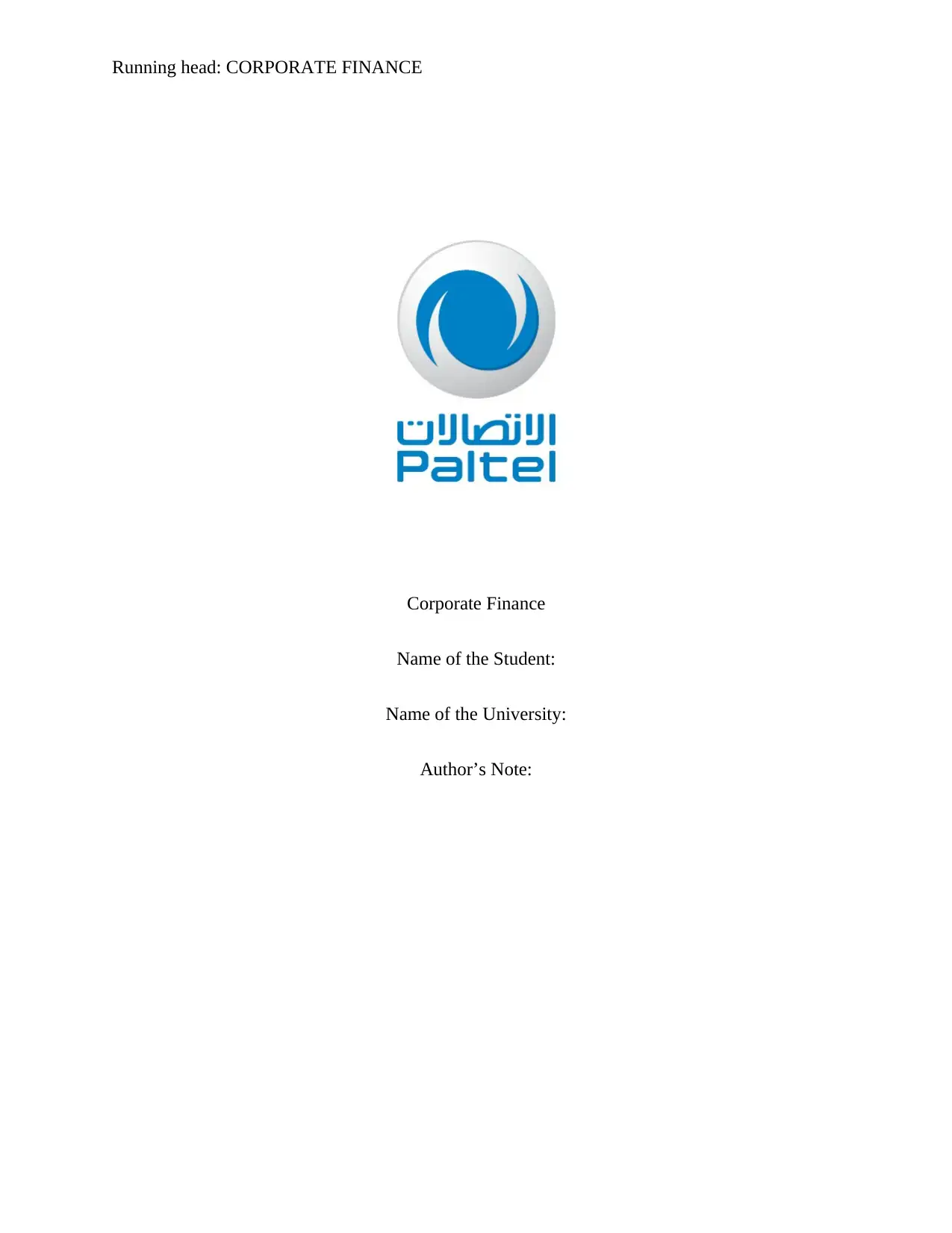
Running head: CORPORATE FINANCE
Corporate Finance
Name of the Student:
Name of the University:
Author’s Note:
Corporate Finance
Name of the Student:
Name of the University:
Author’s Note:
Secure Best Marks with AI Grader
Need help grading? Try our AI Grader for instant feedback on your assignments.
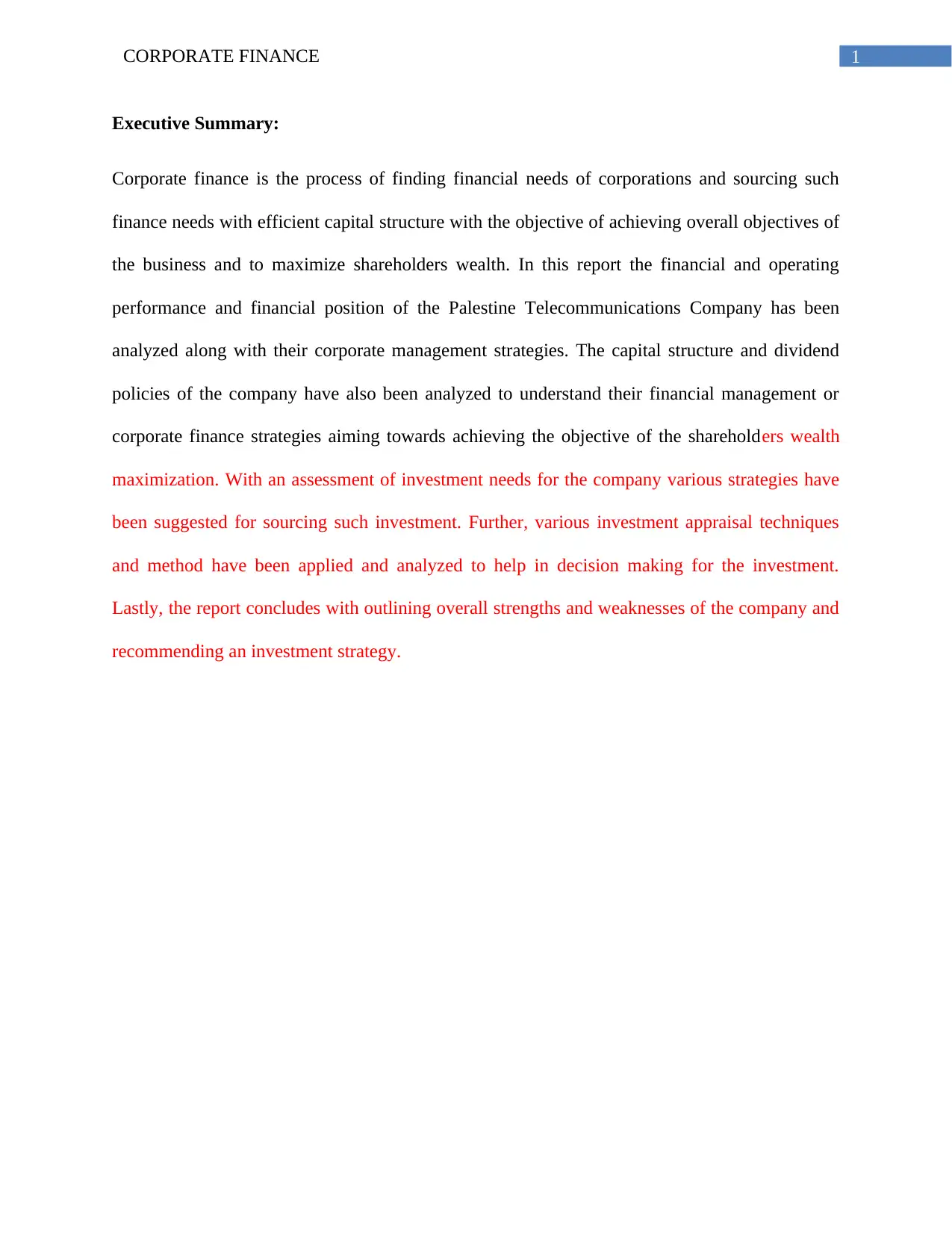
1CORPORATE FINANCE
Executive Summary:
Corporate finance is the process of finding financial needs of corporations and sourcing such
finance needs with efficient capital structure with the objective of achieving overall objectives of
the business and to maximize shareholders wealth. In this report the financial and operating
performance and financial position of the Palestine Telecommunications Company has been
analyzed along with their corporate management strategies. The capital structure and dividend
policies of the company have also been analyzed to understand their financial management or
corporate finance strategies aiming towards achieving the objective of the shareholders wealth
maximization. With an assessment of investment needs for the company various strategies have
been suggested for sourcing such investment. Further, various investment appraisal techniques
and method have been applied and analyzed to help in decision making for the investment.
Lastly, the report concludes with outlining overall strengths and weaknesses of the company and
recommending an investment strategy.
Executive Summary:
Corporate finance is the process of finding financial needs of corporations and sourcing such
finance needs with efficient capital structure with the objective of achieving overall objectives of
the business and to maximize shareholders wealth. In this report the financial and operating
performance and financial position of the Palestine Telecommunications Company has been
analyzed along with their corporate management strategies. The capital structure and dividend
policies of the company have also been analyzed to understand their financial management or
corporate finance strategies aiming towards achieving the objective of the shareholders wealth
maximization. With an assessment of investment needs for the company various strategies have
been suggested for sourcing such investment. Further, various investment appraisal techniques
and method have been applied and analyzed to help in decision making for the investment.
Lastly, the report concludes with outlining overall strengths and weaknesses of the company and
recommending an investment strategy.
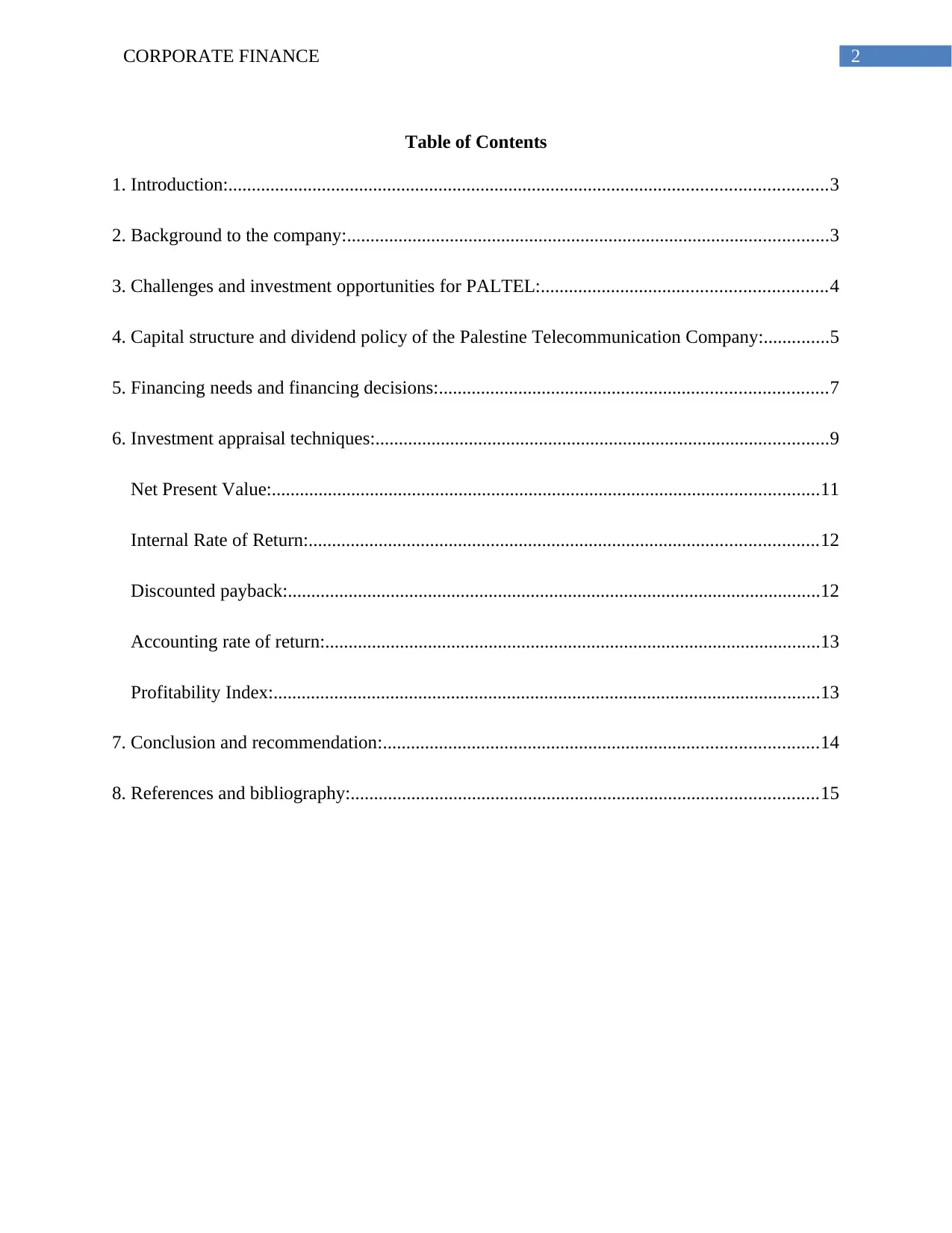
2CORPORATE FINANCE
Table of Contents
1. Introduction:................................................................................................................................3
2. Background to the company:.......................................................................................................3
3. Challenges and investment opportunities for PALTEL:.............................................................4
4. Capital structure and dividend policy of the Palestine Telecommunication Company:..............5
5. Financing needs and financing decisions:...................................................................................7
6. Investment appraisal techniques:.................................................................................................9
Net Present Value:.....................................................................................................................11
Internal Rate of Return:.............................................................................................................12
Discounted payback:..................................................................................................................12
Accounting rate of return:..........................................................................................................13
Profitability Index:.....................................................................................................................13
7. Conclusion and recommendation:.............................................................................................14
8. References and bibliography:....................................................................................................15
Table of Contents
1. Introduction:................................................................................................................................3
2. Background to the company:.......................................................................................................3
3. Challenges and investment opportunities for PALTEL:.............................................................4
4. Capital structure and dividend policy of the Palestine Telecommunication Company:..............5
5. Financing needs and financing decisions:...................................................................................7
6. Investment appraisal techniques:.................................................................................................9
Net Present Value:.....................................................................................................................11
Internal Rate of Return:.............................................................................................................12
Discounted payback:..................................................................................................................12
Accounting rate of return:..........................................................................................................13
Profitability Index:.....................................................................................................................13
7. Conclusion and recommendation:.............................................................................................14
8. References and bibliography:....................................................................................................15
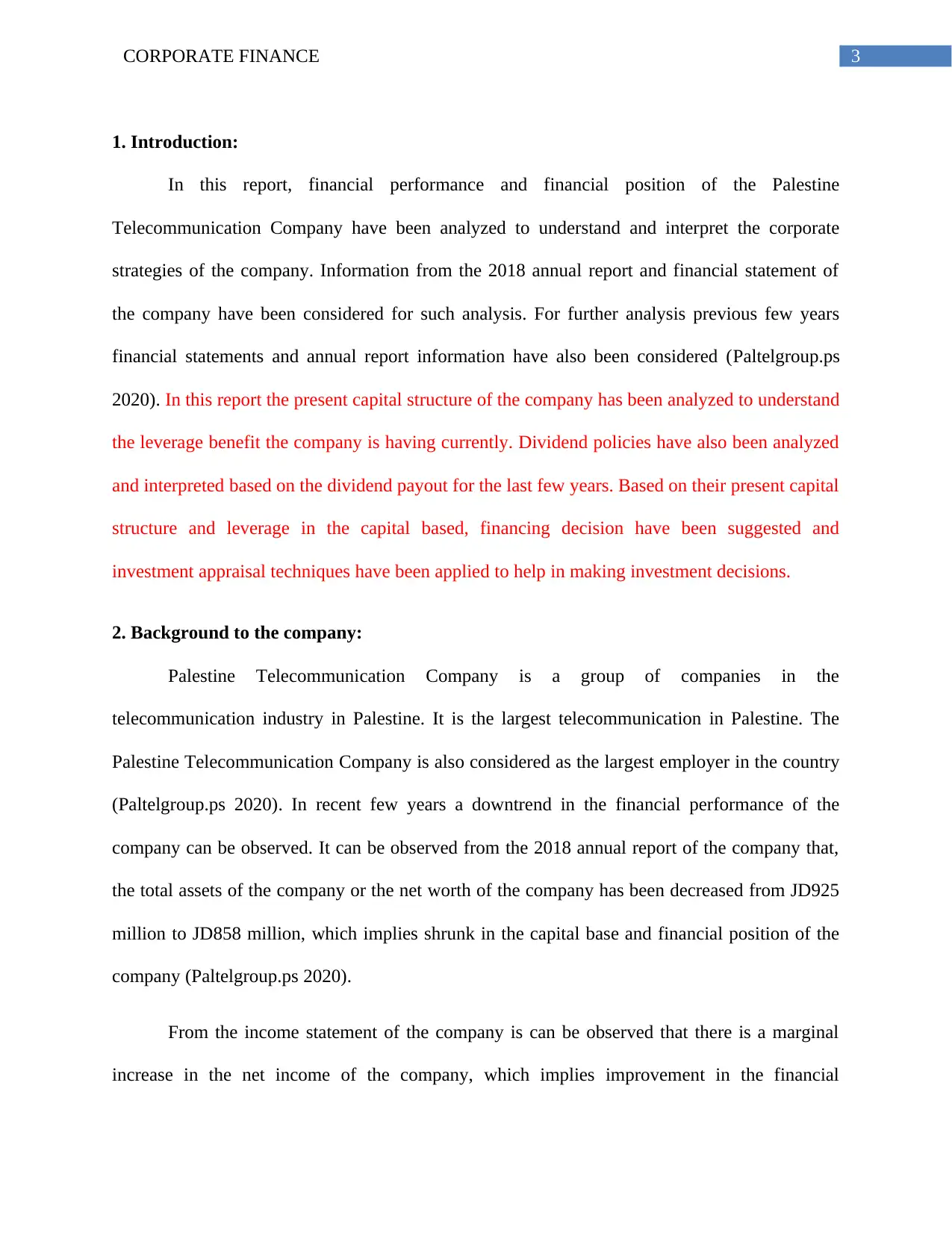
3CORPORATE FINANCE
1. Introduction:
In this report, financial performance and financial position of the Palestine
Telecommunication Company have been analyzed to understand and interpret the corporate
strategies of the company. Information from the 2018 annual report and financial statement of
the company have been considered for such analysis. For further analysis previous few years
financial statements and annual report information have also been considered (Paltelgroup.ps
2020). In this report the present capital structure of the company has been analyzed to understand
the leverage benefit the company is having currently. Dividend policies have also been analyzed
and interpreted based on the dividend payout for the last few years. Based on their present capital
structure and leverage in the capital based, financing decision have been suggested and
investment appraisal techniques have been applied to help in making investment decisions.
2. Background to the company:
Palestine Telecommunication Company is a group of companies in the
telecommunication industry in Palestine. It is the largest telecommunication in Palestine. The
Palestine Telecommunication Company is also considered as the largest employer in the country
(Paltelgroup.ps 2020). In recent few years a downtrend in the financial performance of the
company can be observed. It can be observed from the 2018 annual report of the company that,
the total assets of the company or the net worth of the company has been decreased from JD925
million to JD858 million, which implies shrunk in the capital base and financial position of the
company (Paltelgroup.ps 2020).
From the income statement of the company is can be observed that there is a marginal
increase in the net income of the company, which implies improvement in the financial
1. Introduction:
In this report, financial performance and financial position of the Palestine
Telecommunication Company have been analyzed to understand and interpret the corporate
strategies of the company. Information from the 2018 annual report and financial statement of
the company have been considered for such analysis. For further analysis previous few years
financial statements and annual report information have also been considered (Paltelgroup.ps
2020). In this report the present capital structure of the company has been analyzed to understand
the leverage benefit the company is having currently. Dividend policies have also been analyzed
and interpreted based on the dividend payout for the last few years. Based on their present capital
structure and leverage in the capital based, financing decision have been suggested and
investment appraisal techniques have been applied to help in making investment decisions.
2. Background to the company:
Palestine Telecommunication Company is a group of companies in the
telecommunication industry in Palestine. It is the largest telecommunication in Palestine. The
Palestine Telecommunication Company is also considered as the largest employer in the country
(Paltelgroup.ps 2020). In recent few years a downtrend in the financial performance of the
company can be observed. It can be observed from the 2018 annual report of the company that,
the total assets of the company or the net worth of the company has been decreased from JD925
million to JD858 million, which implies shrunk in the capital base and financial position of the
company (Paltelgroup.ps 2020).
From the income statement of the company is can be observed that there is a marginal
increase in the net income of the company, which implies improvement in the financial
Secure Best Marks with AI Grader
Need help grading? Try our AI Grader for instant feedback on your assignments.
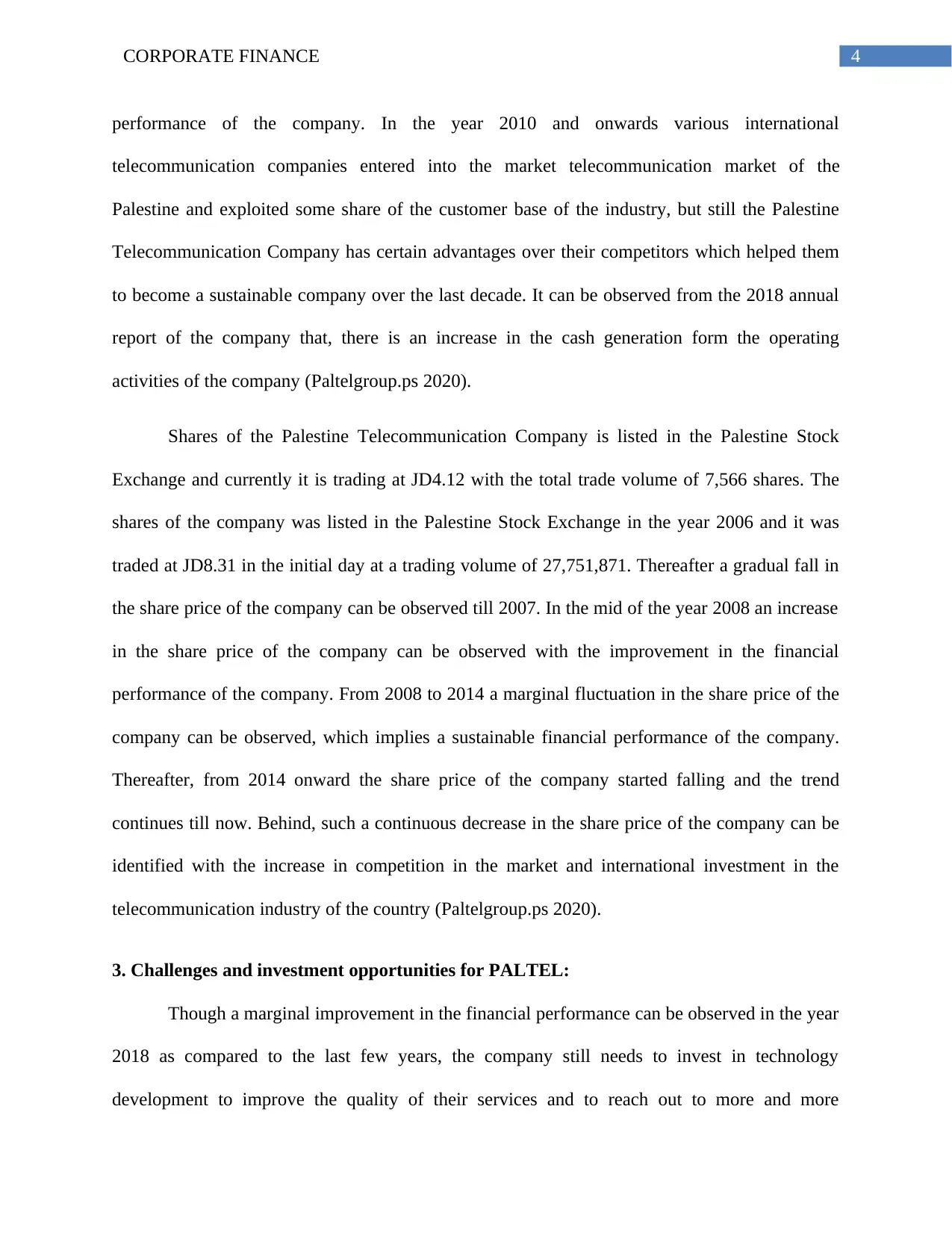
4CORPORATE FINANCE
performance of the company. In the year 2010 and onwards various international
telecommunication companies entered into the market telecommunication market of the
Palestine and exploited some share of the customer base of the industry, but still the Palestine
Telecommunication Company has certain advantages over their competitors which helped them
to become a sustainable company over the last decade. It can be observed from the 2018 annual
report of the company that, there is an increase in the cash generation form the operating
activities of the company (Paltelgroup.ps 2020).
Shares of the Palestine Telecommunication Company is listed in the Palestine Stock
Exchange and currently it is trading at JD4.12 with the total trade volume of 7,566 shares. The
shares of the company was listed in the Palestine Stock Exchange in the year 2006 and it was
traded at JD8.31 in the initial day at a trading volume of 27,751,871. Thereafter a gradual fall in
the share price of the company can be observed till 2007. In the mid of the year 2008 an increase
in the share price of the company can be observed with the improvement in the financial
performance of the company. From 2008 to 2014 a marginal fluctuation in the share price of the
company can be observed, which implies a sustainable financial performance of the company.
Thereafter, from 2014 onward the share price of the company started falling and the trend
continues till now. Behind, such a continuous decrease in the share price of the company can be
identified with the increase in competition in the market and international investment in the
telecommunication industry of the country (Paltelgroup.ps 2020).
3. Challenges and investment opportunities for PALTEL:
Though a marginal improvement in the financial performance can be observed in the year
2018 as compared to the last few years, the company still needs to invest in technology
development to improve the quality of their services and to reach out to more and more
performance of the company. In the year 2010 and onwards various international
telecommunication companies entered into the market telecommunication market of the
Palestine and exploited some share of the customer base of the industry, but still the Palestine
Telecommunication Company has certain advantages over their competitors which helped them
to become a sustainable company over the last decade. It can be observed from the 2018 annual
report of the company that, there is an increase in the cash generation form the operating
activities of the company (Paltelgroup.ps 2020).
Shares of the Palestine Telecommunication Company is listed in the Palestine Stock
Exchange and currently it is trading at JD4.12 with the total trade volume of 7,566 shares. The
shares of the company was listed in the Palestine Stock Exchange in the year 2006 and it was
traded at JD8.31 in the initial day at a trading volume of 27,751,871. Thereafter a gradual fall in
the share price of the company can be observed till 2007. In the mid of the year 2008 an increase
in the share price of the company can be observed with the improvement in the financial
performance of the company. From 2008 to 2014 a marginal fluctuation in the share price of the
company can be observed, which implies a sustainable financial performance of the company.
Thereafter, from 2014 onward the share price of the company started falling and the trend
continues till now. Behind, such a continuous decrease in the share price of the company can be
identified with the increase in competition in the market and international investment in the
telecommunication industry of the country (Paltelgroup.ps 2020).
3. Challenges and investment opportunities for PALTEL:
Though a marginal improvement in the financial performance can be observed in the year
2018 as compared to the last few years, the company still needs to invest in technology
development to improve the quality of their services and to reach out to more and more
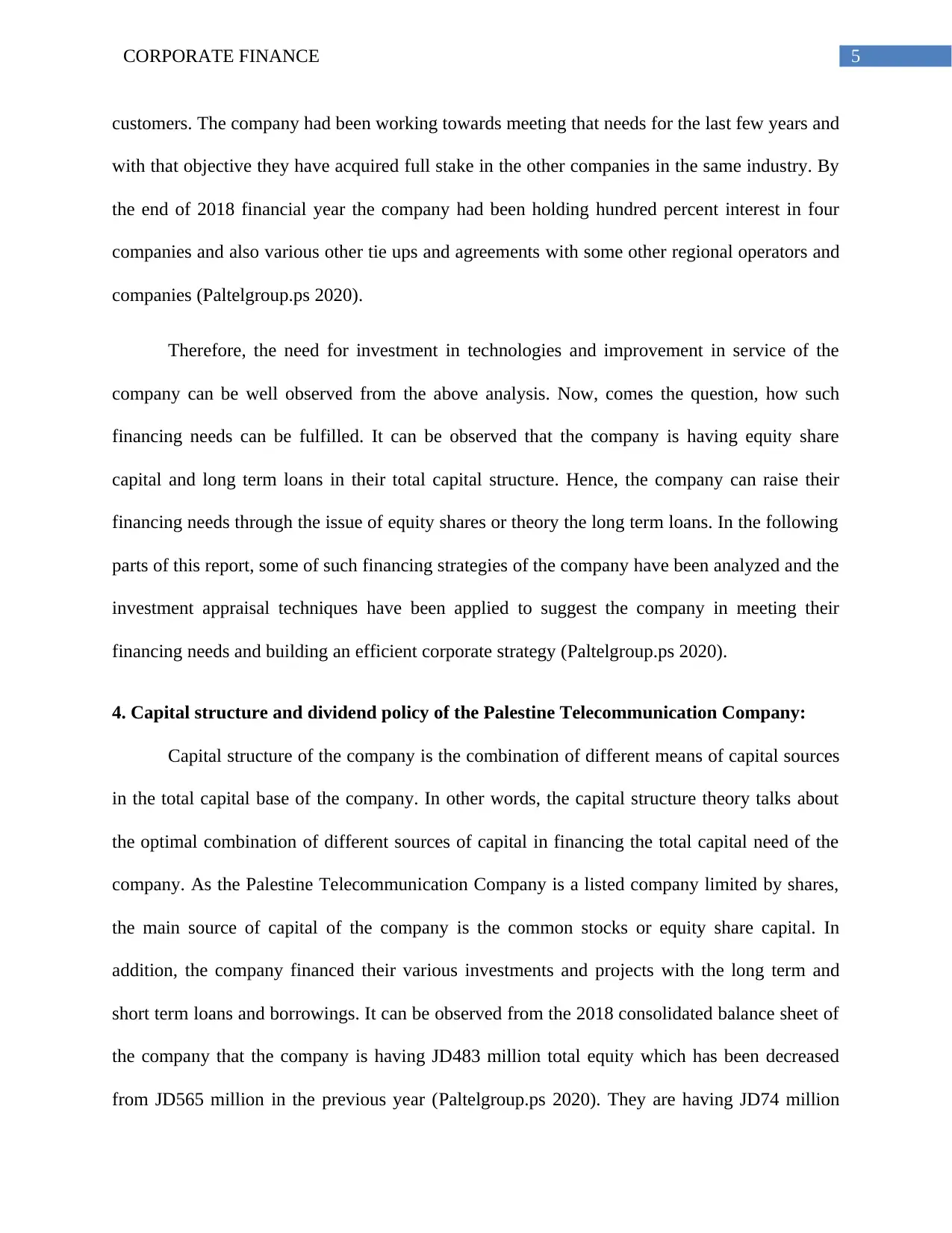
5CORPORATE FINANCE
customers. The company had been working towards meeting that needs for the last few years and
with that objective they have acquired full stake in the other companies in the same industry. By
the end of 2018 financial year the company had been holding hundred percent interest in four
companies and also various other tie ups and agreements with some other regional operators and
companies (Paltelgroup.ps 2020).
Therefore, the need for investment in technologies and improvement in service of the
company can be well observed from the above analysis. Now, comes the question, how such
financing needs can be fulfilled. It can be observed that the company is having equity share
capital and long term loans in their total capital structure. Hence, the company can raise their
financing needs through the issue of equity shares or theory the long term loans. In the following
parts of this report, some of such financing strategies of the company have been analyzed and the
investment appraisal techniques have been applied to suggest the company in meeting their
financing needs and building an efficient corporate strategy (Paltelgroup.ps 2020).
4. Capital structure and dividend policy of the Palestine Telecommunication Company:
Capital structure of the company is the combination of different means of capital sources
in the total capital base of the company. In other words, the capital structure theory talks about
the optimal combination of different sources of capital in financing the total capital need of the
company. As the Palestine Telecommunication Company is a listed company limited by shares,
the main source of capital of the company is the common stocks or equity share capital. In
addition, the company financed their various investments and projects with the long term and
short term loans and borrowings. It can be observed from the 2018 consolidated balance sheet of
the company that the company is having JD483 million total equity which has been decreased
from JD565 million in the previous year (Paltelgroup.ps 2020). They are having JD74 million
customers. The company had been working towards meeting that needs for the last few years and
with that objective they have acquired full stake in the other companies in the same industry. By
the end of 2018 financial year the company had been holding hundred percent interest in four
companies and also various other tie ups and agreements with some other regional operators and
companies (Paltelgroup.ps 2020).
Therefore, the need for investment in technologies and improvement in service of the
company can be well observed from the above analysis. Now, comes the question, how such
financing needs can be fulfilled. It can be observed that the company is having equity share
capital and long term loans in their total capital structure. Hence, the company can raise their
financing needs through the issue of equity shares or theory the long term loans. In the following
parts of this report, some of such financing strategies of the company have been analyzed and the
investment appraisal techniques have been applied to suggest the company in meeting their
financing needs and building an efficient corporate strategy (Paltelgroup.ps 2020).
4. Capital structure and dividend policy of the Palestine Telecommunication Company:
Capital structure of the company is the combination of different means of capital sources
in the total capital base of the company. In other words, the capital structure theory talks about
the optimal combination of different sources of capital in financing the total capital need of the
company. As the Palestine Telecommunication Company is a listed company limited by shares,
the main source of capital of the company is the common stocks or equity share capital. In
addition, the company financed their various investments and projects with the long term and
short term loans and borrowings. It can be observed from the 2018 consolidated balance sheet of
the company that the company is having JD483 million total equity which has been decreased
from JD565 million in the previous year (Paltelgroup.ps 2020). They are having JD74 million
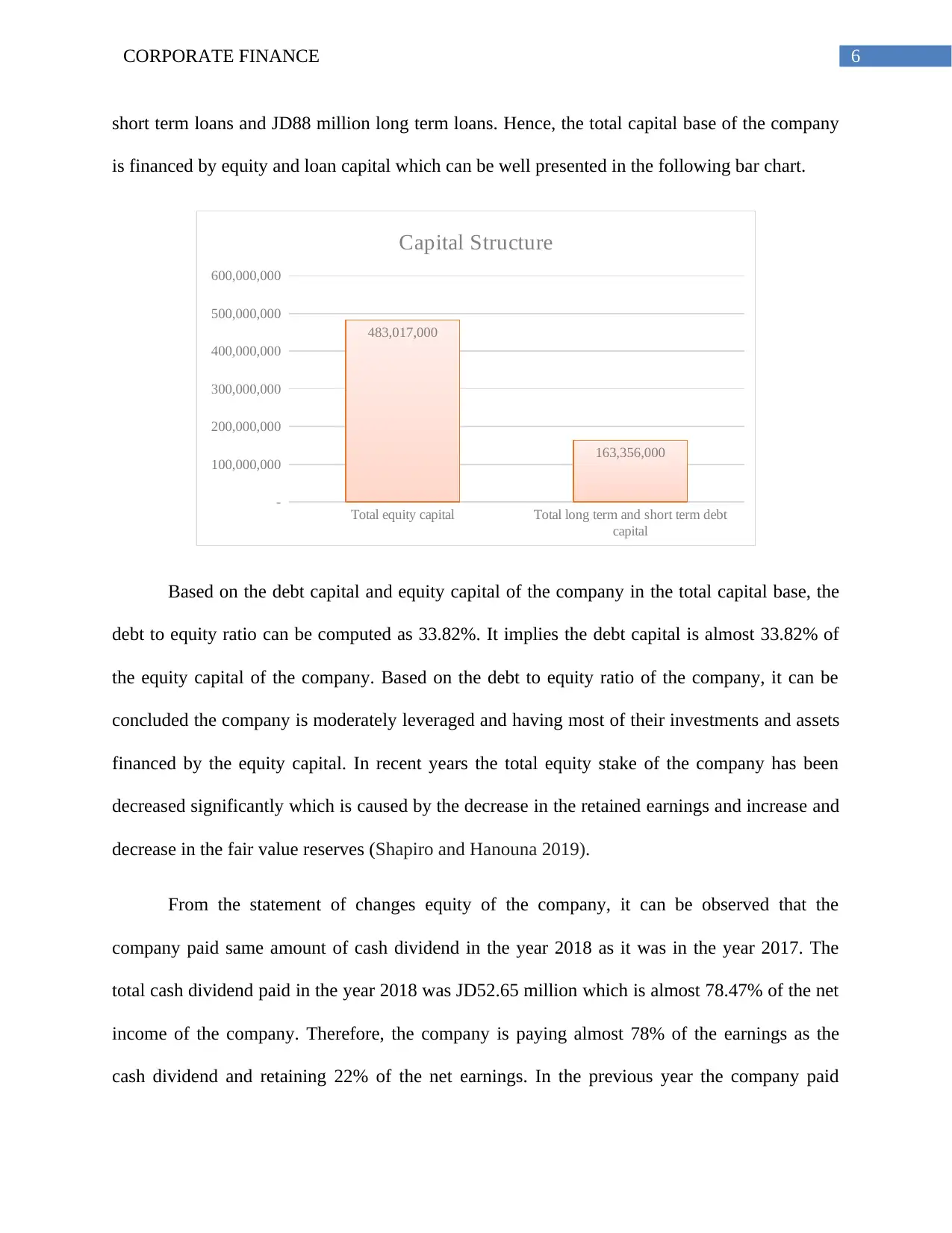
6CORPORATE FINANCE
short term loans and JD88 million long term loans. Hence, the total capital base of the company
is financed by equity and loan capital which can be well presented in the following bar chart.
Total equity capital Total long term and short term debt
capital
-
100,000,000
200,000,000
300,000,000
400,000,000
500,000,000
600,000,000
483,017,000
163,356,000
Capital Structure
Based on the debt capital and equity capital of the company in the total capital base, the
debt to equity ratio can be computed as 33.82%. It implies the debt capital is almost 33.82% of
the equity capital of the company. Based on the debt to equity ratio of the company, it can be
concluded the company is moderately leveraged and having most of their investments and assets
financed by the equity capital. In recent years the total equity stake of the company has been
decreased significantly which is caused by the decrease in the retained earnings and increase and
decrease in the fair value reserves (Shapiro and Hanouna 2019).
From the statement of changes equity of the company, it can be observed that the
company paid same amount of cash dividend in the year 2018 as it was in the year 2017. The
total cash dividend paid in the year 2018 was JD52.65 million which is almost 78.47% of the net
income of the company. Therefore, the company is paying almost 78% of the earnings as the
cash dividend and retaining 22% of the net earnings. In the previous year the company paid
short term loans and JD88 million long term loans. Hence, the total capital base of the company
is financed by equity and loan capital which can be well presented in the following bar chart.
Total equity capital Total long term and short term debt
capital
-
100,000,000
200,000,000
300,000,000
400,000,000
500,000,000
600,000,000
483,017,000
163,356,000
Capital Structure
Based on the debt capital and equity capital of the company in the total capital base, the
debt to equity ratio can be computed as 33.82%. It implies the debt capital is almost 33.82% of
the equity capital of the company. Based on the debt to equity ratio of the company, it can be
concluded the company is moderately leveraged and having most of their investments and assets
financed by the equity capital. In recent years the total equity stake of the company has been
decreased significantly which is caused by the decrease in the retained earnings and increase and
decrease in the fair value reserves (Shapiro and Hanouna 2019).
From the statement of changes equity of the company, it can be observed that the
company paid same amount of cash dividend in the year 2018 as it was in the year 2017. The
total cash dividend paid in the year 2018 was JD52.65 million which is almost 78.47% of the net
income of the company. Therefore, the company is paying almost 78% of the earnings as the
cash dividend and retaining 22% of the net earnings. In the previous year the company paid
Paraphrase This Document
Need a fresh take? Get an instant paraphrase of this document with our AI Paraphraser
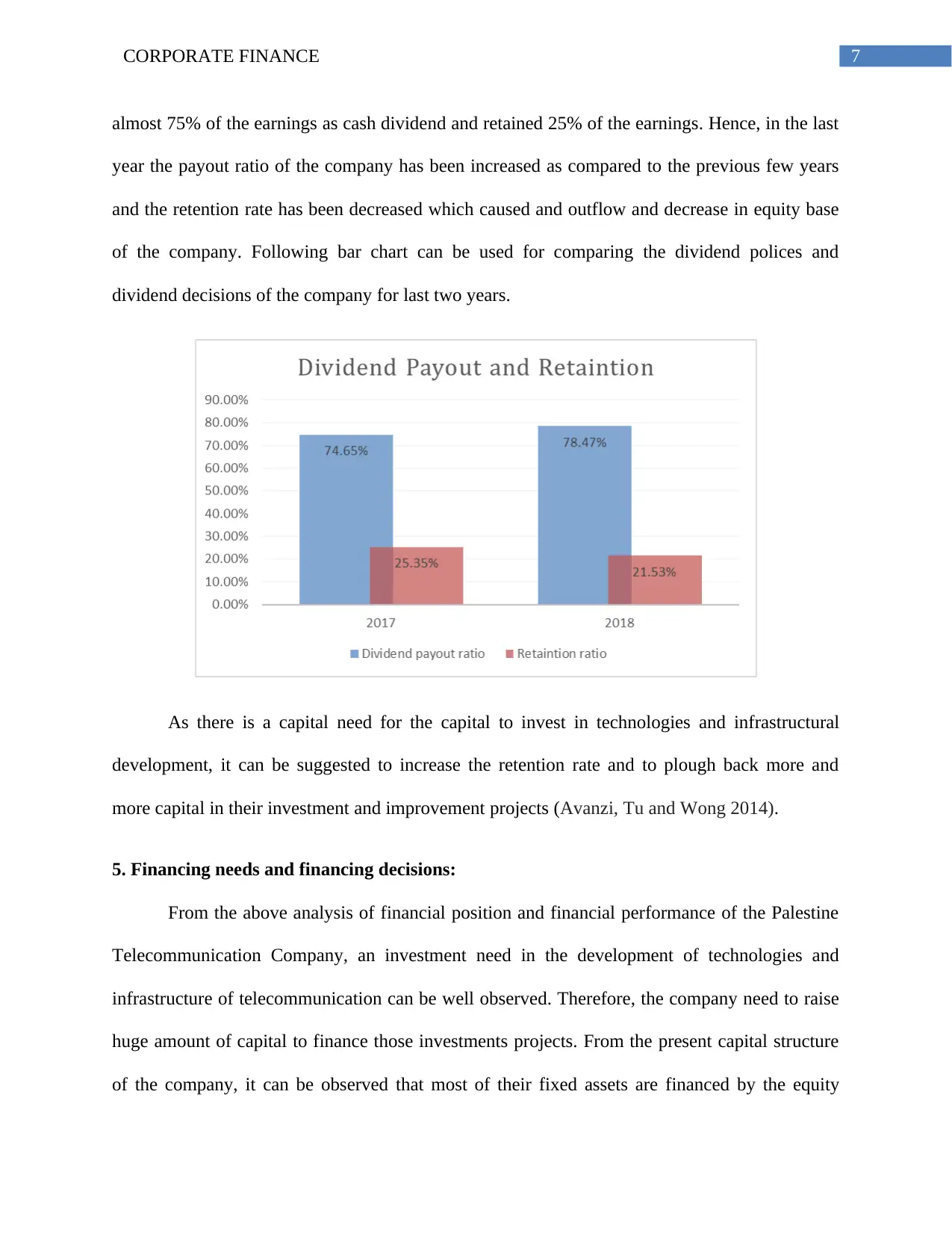
7CORPORATE FINANCE
almost 75% of the earnings as cash dividend and retained 25% of the earnings. Hence, in the last
year the payout ratio of the company has been increased as compared to the previous few years
and the retention rate has been decreased which caused and outflow and decrease in equity base
of the company. Following bar chart can be used for comparing the dividend polices and
dividend decisions of the company for last two years.
As there is a capital need for the capital to invest in technologies and infrastructural
development, it can be suggested to increase the retention rate and to plough back more and
more capital in their investment and improvement projects (Avanzi, Tu and Wong 2014).
5. Financing needs and financing decisions:
From the above analysis of financial position and financial performance of the Palestine
Telecommunication Company, an investment need in the development of technologies and
infrastructure of telecommunication can be well observed. Therefore, the company need to raise
huge amount of capital to finance those investments projects. From the present capital structure
of the company, it can be observed that most of their fixed assets are financed by the equity
almost 75% of the earnings as cash dividend and retained 25% of the earnings. Hence, in the last
year the payout ratio of the company has been increased as compared to the previous few years
and the retention rate has been decreased which caused and outflow and decrease in equity base
of the company. Following bar chart can be used for comparing the dividend polices and
dividend decisions of the company for last two years.
As there is a capital need for the capital to invest in technologies and infrastructural
development, it can be suggested to increase the retention rate and to plough back more and
more capital in their investment and improvement projects (Avanzi, Tu and Wong 2014).
5. Financing needs and financing decisions:
From the above analysis of financial position and financial performance of the Palestine
Telecommunication Company, an investment need in the development of technologies and
infrastructure of telecommunication can be well observed. Therefore, the company need to raise
huge amount of capital to finance those investments projects. From the present capital structure
of the company, it can be observed that most of their fixed assets are financed by the equity
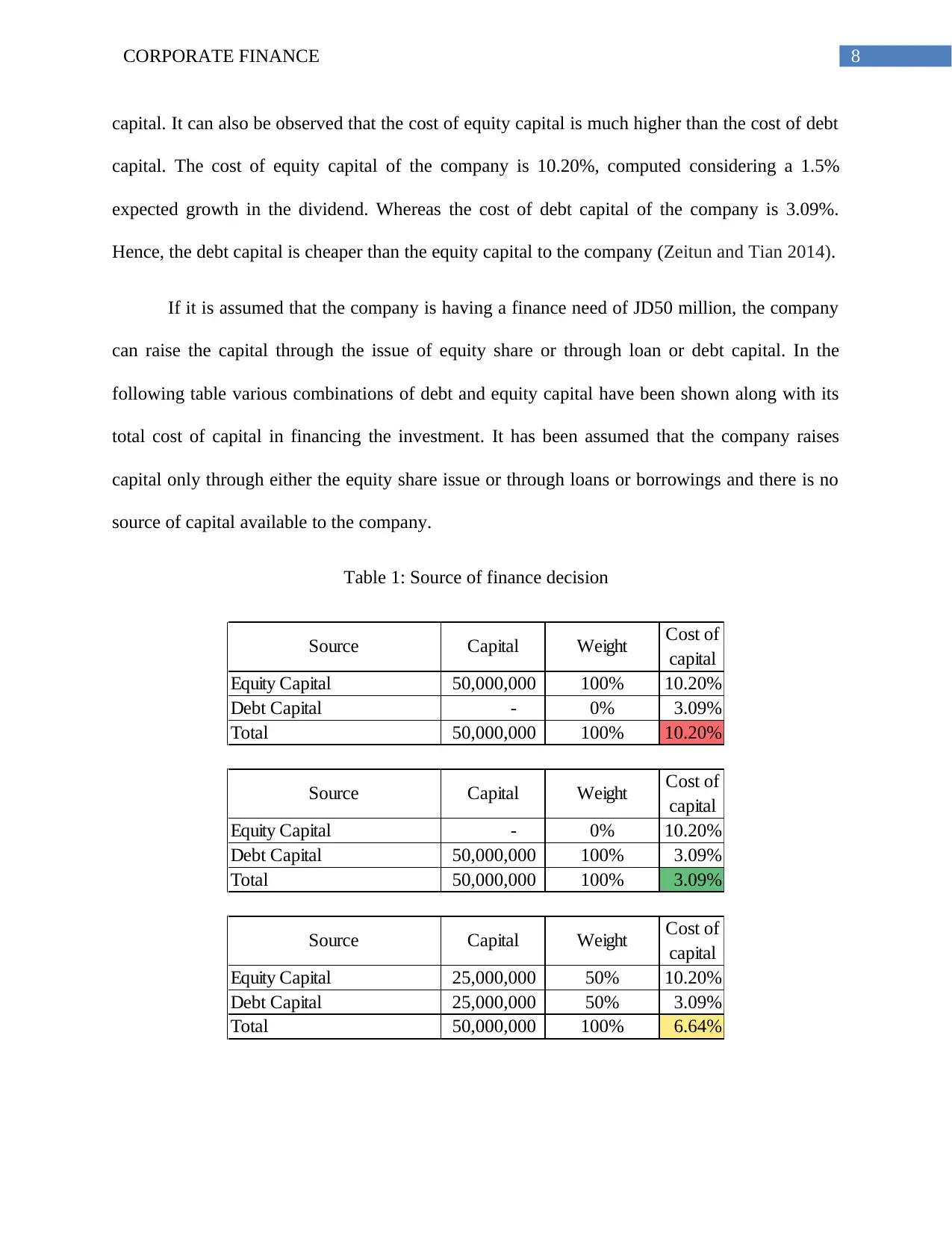
8CORPORATE FINANCE
capital. It can also be observed that the cost of equity capital is much higher than the cost of debt
capital. The cost of equity capital of the company is 10.20%, computed considering a 1.5%
expected growth in the dividend. Whereas the cost of debt capital of the company is 3.09%.
Hence, the debt capital is cheaper than the equity capital to the company (Zeitun and Tian 2014).
If it is assumed that the company is having a finance need of JD50 million, the company
can raise the capital through the issue of equity share or through loan or debt capital. In the
following table various combinations of debt and equity capital have been shown along with its
total cost of capital in financing the investment. It has been assumed that the company raises
capital only through either the equity share issue or through loans or borrowings and there is no
source of capital available to the company.
Table 1: Source of finance decision
Source Capital Weight Cost of
capital
Equity Capital 50,000,000 100% 10.20%
Debt Capital - 0% 3.09%
Total 50,000,000 100% 10.20%
Source Capital Weight Cost of
capital
Equity Capital - 0% 10.20%
Debt Capital 50,000,000 100% 3.09%
Total 50,000,000 100% 3.09%
Source Capital Weight Cost of
capital
Equity Capital 25,000,000 50% 10.20%
Debt Capital 25,000,000 50% 3.09%
Total 50,000,000 100% 6.64%
Equity Capital 20,000,000 40% 10.20%
Debt Capital 30,000,000 60% 3.09%
Total 50,000,000 100% 5.93%
capital. It can also be observed that the cost of equity capital is much higher than the cost of debt
capital. The cost of equity capital of the company is 10.20%, computed considering a 1.5%
expected growth in the dividend. Whereas the cost of debt capital of the company is 3.09%.
Hence, the debt capital is cheaper than the equity capital to the company (Zeitun and Tian 2014).
If it is assumed that the company is having a finance need of JD50 million, the company
can raise the capital through the issue of equity share or through loan or debt capital. In the
following table various combinations of debt and equity capital have been shown along with its
total cost of capital in financing the investment. It has been assumed that the company raises
capital only through either the equity share issue or through loans or borrowings and there is no
source of capital available to the company.
Table 1: Source of finance decision
Source Capital Weight Cost of
capital
Equity Capital 50,000,000 100% 10.20%
Debt Capital - 0% 3.09%
Total 50,000,000 100% 10.20%
Source Capital Weight Cost of
capital
Equity Capital - 0% 10.20%
Debt Capital 50,000,000 100% 3.09%
Total 50,000,000 100% 3.09%
Source Capital Weight Cost of
capital
Equity Capital 25,000,000 50% 10.20%
Debt Capital 25,000,000 50% 3.09%
Total 50,000,000 100% 6.64%
Equity Capital 20,000,000 40% 10.20%
Debt Capital 30,000,000 60% 3.09%
Total 50,000,000 100% 5.93%
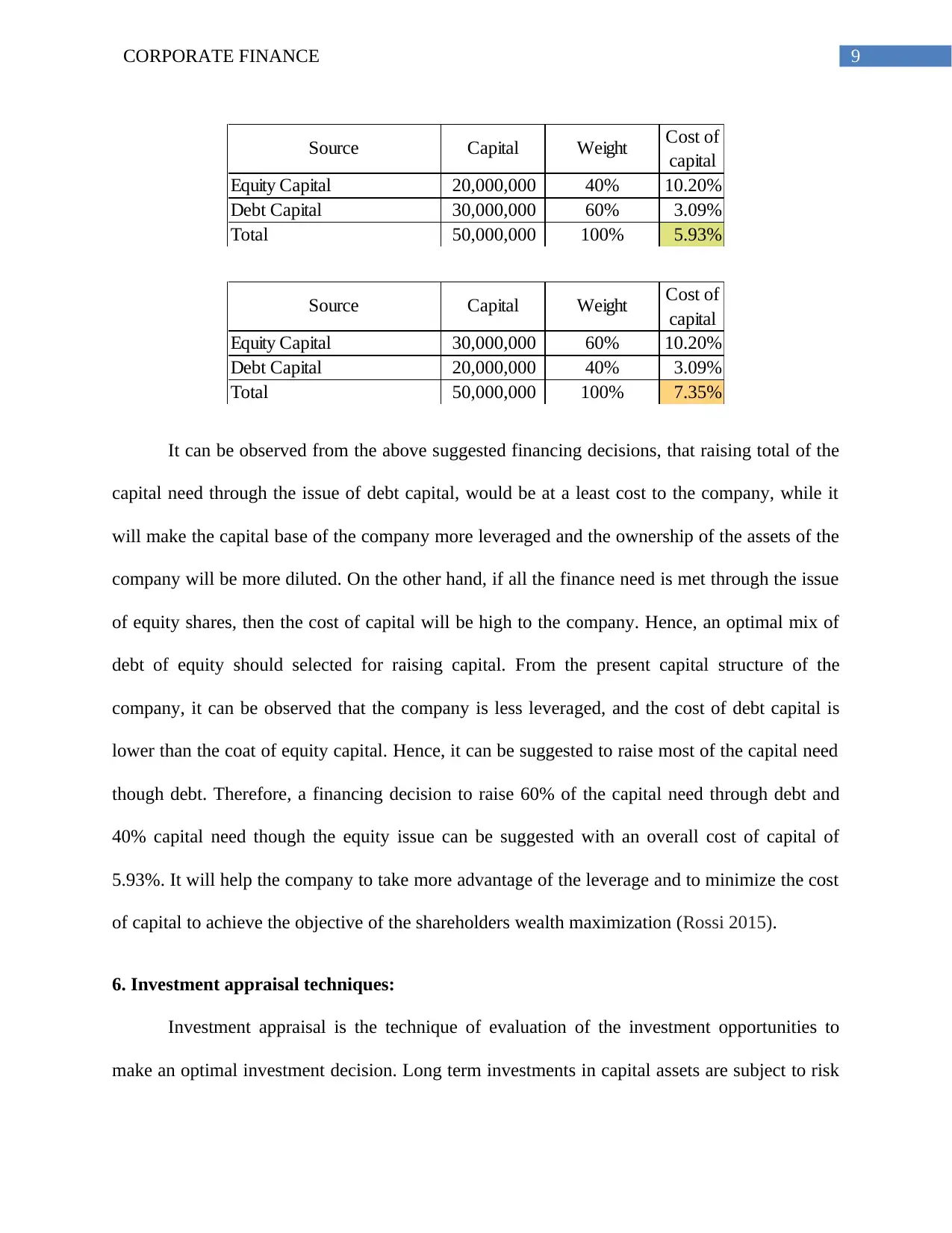
9CORPORATE FINANCE
Equity Capital 25,000,000 50% 10.20%
Debt Capital 25,000,000 50% 3.09%
Total 50,000,000 100% 6.64%
Source Capital Weight Cost of
capital
Equity Capital 20,000,000 40% 10.20%
Debt Capital 30,000,000 60% 3.09%
Total 50,000,000 100% 5.93%
Source Capital Weight Cost of
capital
Equity Capital 30,000,000 60% 10.20%
Debt Capital 20,000,000 40% 3.09%
Total 50,000,000 100% 7.35%
It can be observed from the above suggested financing decisions, that raising total of the
capital need through the issue of debt capital, would be at a least cost to the company, while it
will make the capital base of the company more leveraged and the ownership of the assets of the
company will be more diluted. On the other hand, if all the finance need is met through the issue
of equity shares, then the cost of capital will be high to the company. Hence, an optimal mix of
debt of equity should selected for raising capital. From the present capital structure of the
company, it can be observed that the company is less leveraged, and the cost of debt capital is
lower than the coat of equity capital. Hence, it can be suggested to raise most of the capital need
though debt. Therefore, a financing decision to raise 60% of the capital need through debt and
40% capital need though the equity issue can be suggested with an overall cost of capital of
5.93%. It will help the company to take more advantage of the leverage and to minimize the cost
of capital to achieve the objective of the shareholders wealth maximization (Rossi 2015).
6. Investment appraisal techniques:
Investment appraisal is the technique of evaluation of the investment opportunities to
make an optimal investment decision. Long term investments in capital assets are subject to risk
Equity Capital 25,000,000 50% 10.20%
Debt Capital 25,000,000 50% 3.09%
Total 50,000,000 100% 6.64%
Source Capital Weight Cost of
capital
Equity Capital 20,000,000 40% 10.20%
Debt Capital 30,000,000 60% 3.09%
Total 50,000,000 100% 5.93%
Source Capital Weight Cost of
capital
Equity Capital 30,000,000 60% 10.20%
Debt Capital 20,000,000 40% 3.09%
Total 50,000,000 100% 7.35%
It can be observed from the above suggested financing decisions, that raising total of the
capital need through the issue of debt capital, would be at a least cost to the company, while it
will make the capital base of the company more leveraged and the ownership of the assets of the
company will be more diluted. On the other hand, if all the finance need is met through the issue
of equity shares, then the cost of capital will be high to the company. Hence, an optimal mix of
debt of equity should selected for raising capital. From the present capital structure of the
company, it can be observed that the company is less leveraged, and the cost of debt capital is
lower than the coat of equity capital. Hence, it can be suggested to raise most of the capital need
though debt. Therefore, a financing decision to raise 60% of the capital need through debt and
40% capital need though the equity issue can be suggested with an overall cost of capital of
5.93%. It will help the company to take more advantage of the leverage and to minimize the cost
of capital to achieve the objective of the shareholders wealth maximization (Rossi 2015).
6. Investment appraisal techniques:
Investment appraisal is the technique of evaluation of the investment opportunities to
make an optimal investment decision. Long term investments in capital assets are subject to risk
Secure Best Marks with AI Grader
Need help grading? Try our AI Grader for instant feedback on your assignments.
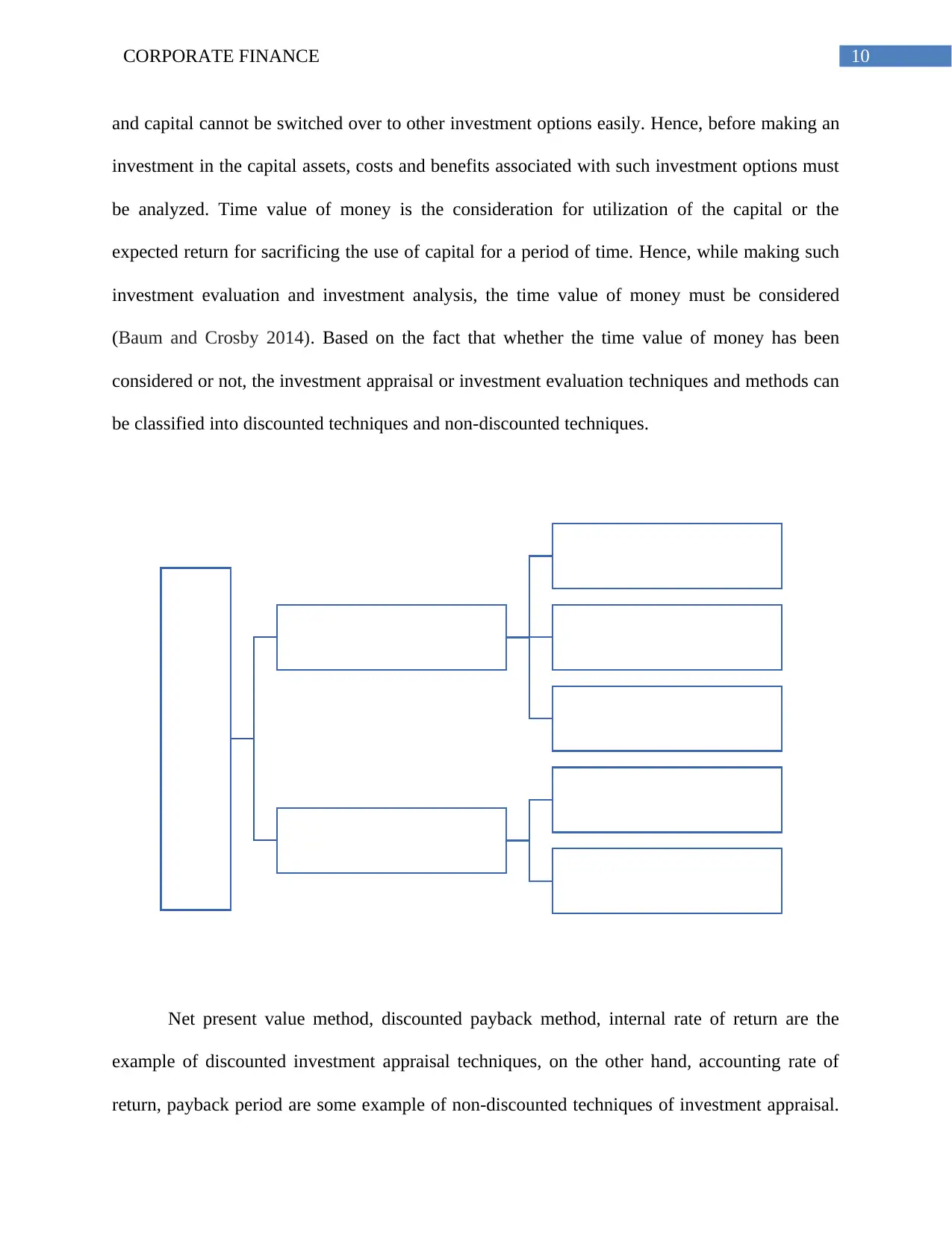
10CORPORATE FINANCE
and capital cannot be switched over to other investment options easily. Hence, before making an
investment in the capital assets, costs and benefits associated with such investment options must
be analyzed. Time value of money is the consideration for utilization of the capital or the
expected return for sacrificing the use of capital for a period of time. Hence, while making such
investment evaluation and investment analysis, the time value of money must be considered
(Baum and Crosby 2014). Based on the fact that whether the time value of money has been
considered or not, the investment appraisal or investment evaluation techniques and methods can
be classified into discounted techniques and non-discounted techniques.
Net present value method, discounted payback method, internal rate of return are the
example of discounted investment appraisal techniques, on the other hand, accounting rate of
return, payback period are some example of non-discounted techniques of investment appraisal.
Investment Appraisal
Techniques
Discounted
Methods
Net Present Value
Internal Rate of
Return
Dicounted
Payback
Non Discounted
Methods
Accounting Rate
of Return
Profitability Index
and capital cannot be switched over to other investment options easily. Hence, before making an
investment in the capital assets, costs and benefits associated with such investment options must
be analyzed. Time value of money is the consideration for utilization of the capital or the
expected return for sacrificing the use of capital for a period of time. Hence, while making such
investment evaluation and investment analysis, the time value of money must be considered
(Baum and Crosby 2014). Based on the fact that whether the time value of money has been
considered or not, the investment appraisal or investment evaluation techniques and methods can
be classified into discounted techniques and non-discounted techniques.
Net present value method, discounted payback method, internal rate of return are the
example of discounted investment appraisal techniques, on the other hand, accounting rate of
return, payback period are some example of non-discounted techniques of investment appraisal.
Investment Appraisal
Techniques
Discounted
Methods
Net Present Value
Internal Rate of
Return
Dicounted
Payback
Non Discounted
Methods
Accounting Rate
of Return
Profitability Index
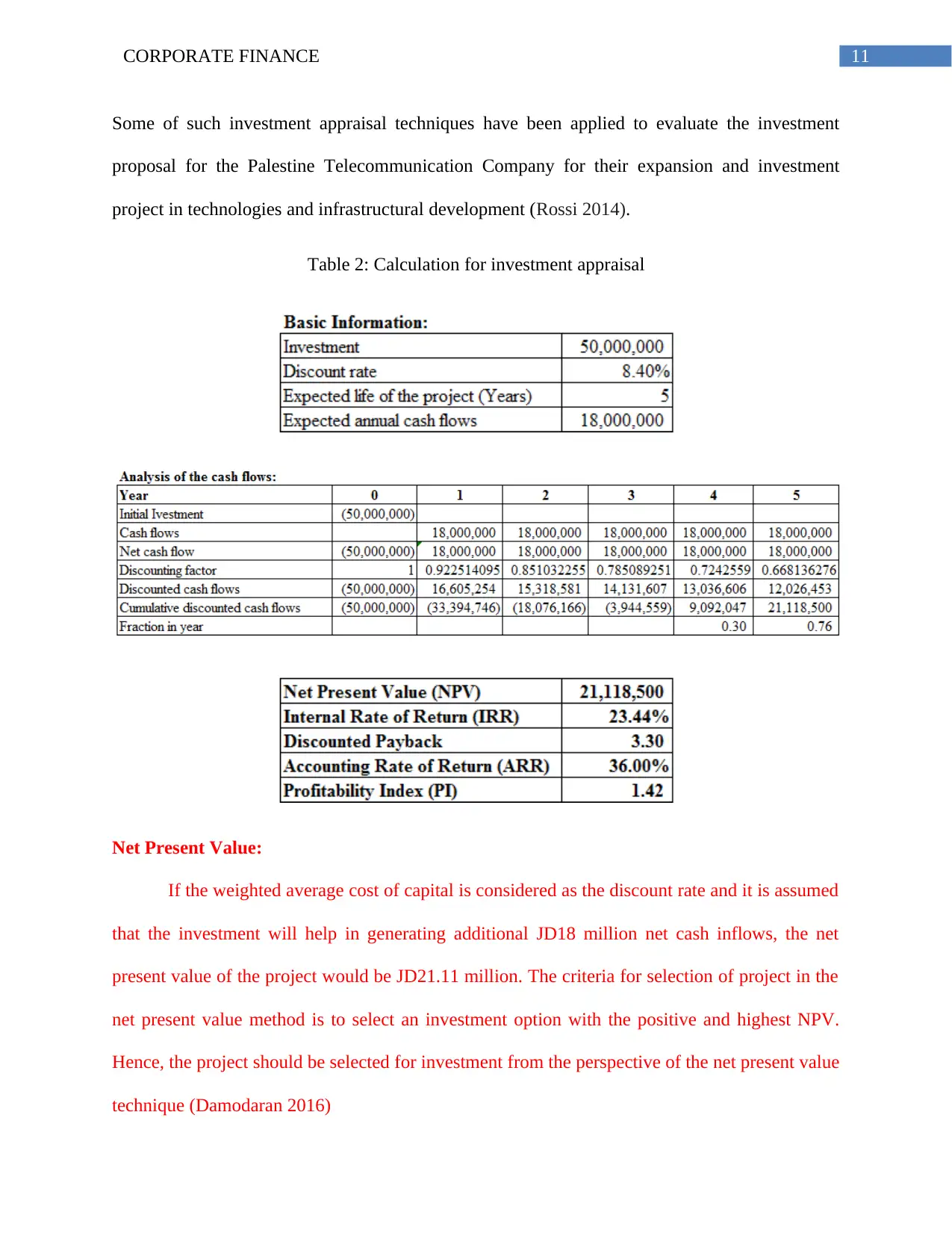
11CORPORATE FINANCE
Some of such investment appraisal techniques have been applied to evaluate the investment
proposal for the Palestine Telecommunication Company for their expansion and investment
project in technologies and infrastructural development (Rossi 2014).
Table 2: Calculation for investment appraisal
Net Present Value:
If the weighted average cost of capital is considered as the discount rate and it is assumed
that the investment will help in generating additional JD18 million net cash inflows, the net
present value of the project would be JD21.11 million. The criteria for selection of project in the
net present value method is to select an investment option with the positive and highest NPV.
Hence, the project should be selected for investment from the perspective of the net present value
technique (Damodaran 2016)
Some of such investment appraisal techniques have been applied to evaluate the investment
proposal for the Palestine Telecommunication Company for their expansion and investment
project in technologies and infrastructural development (Rossi 2014).
Table 2: Calculation for investment appraisal
Net Present Value:
If the weighted average cost of capital is considered as the discount rate and it is assumed
that the investment will help in generating additional JD18 million net cash inflows, the net
present value of the project would be JD21.11 million. The criteria for selection of project in the
net present value method is to select an investment option with the positive and highest NPV.
Hence, the project should be selected for investment from the perspective of the net present value
technique (Damodaran 2016)
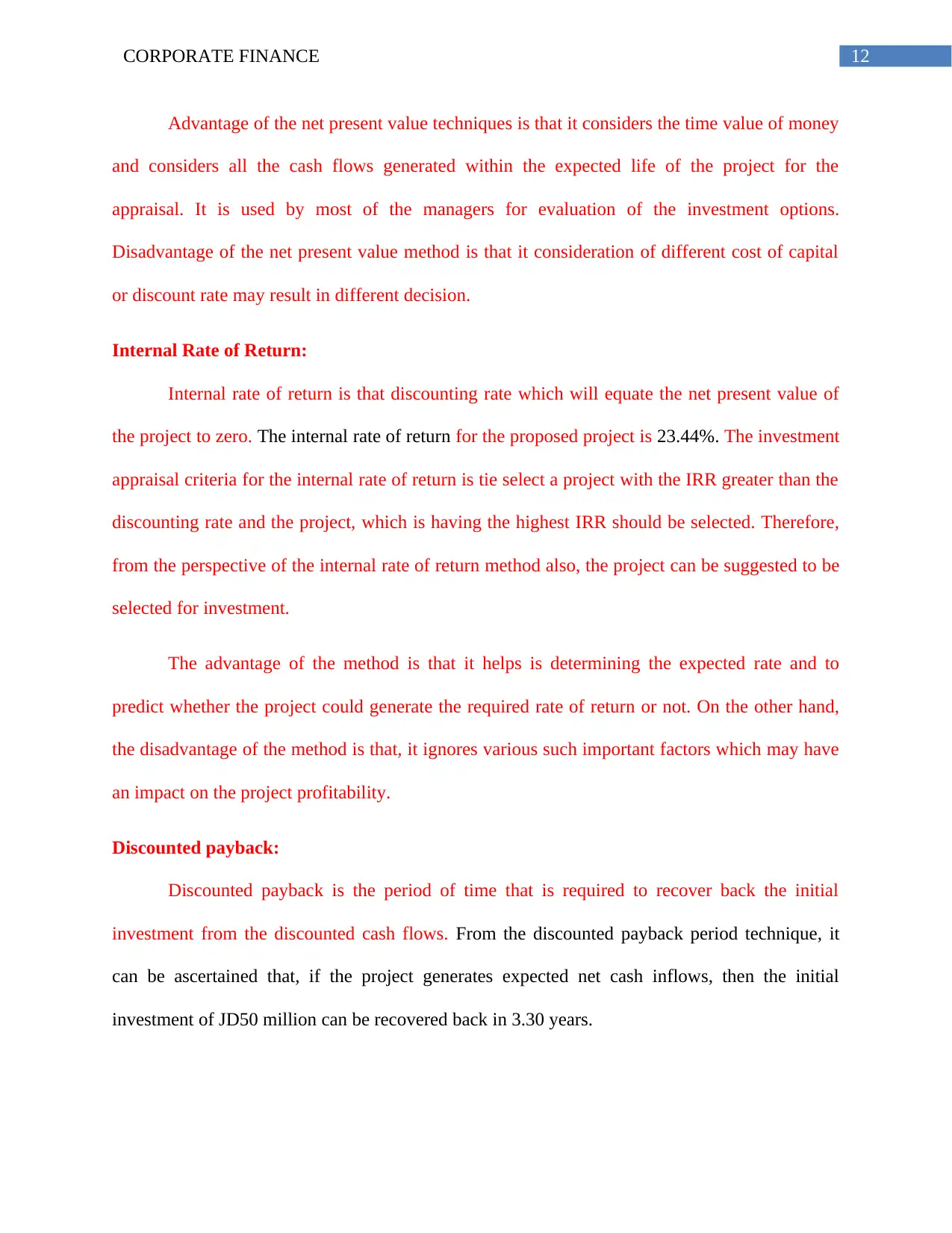
12CORPORATE FINANCE
Advantage of the net present value techniques is that it considers the time value of money
and considers all the cash flows generated within the expected life of the project for the
appraisal. It is used by most of the managers for evaluation of the investment options.
Disadvantage of the net present value method is that it consideration of different cost of capital
or discount rate may result in different decision.
Internal Rate of Return:
Internal rate of return is that discounting rate which will equate the net present value of
the project to zero. The internal rate of return for the proposed project is 23.44%. The investment
appraisal criteria for the internal rate of return is tie select a project with the IRR greater than the
discounting rate and the project, which is having the highest IRR should be selected. Therefore,
from the perspective of the internal rate of return method also, the project can be suggested to be
selected for investment.
The advantage of the method is that it helps is determining the expected rate and to
predict whether the project could generate the required rate of return or not. On the other hand,
the disadvantage of the method is that, it ignores various such important factors which may have
an impact on the project profitability.
Discounted payback:
Discounted payback is the period of time that is required to recover back the initial
investment from the discounted cash flows. From the discounted payback period technique, it
can be ascertained that, if the project generates expected net cash inflows, then the initial
investment of JD50 million can be recovered back in 3.30 years.
Advantage of the net present value techniques is that it considers the time value of money
and considers all the cash flows generated within the expected life of the project for the
appraisal. It is used by most of the managers for evaluation of the investment options.
Disadvantage of the net present value method is that it consideration of different cost of capital
or discount rate may result in different decision.
Internal Rate of Return:
Internal rate of return is that discounting rate which will equate the net present value of
the project to zero. The internal rate of return for the proposed project is 23.44%. The investment
appraisal criteria for the internal rate of return is tie select a project with the IRR greater than the
discounting rate and the project, which is having the highest IRR should be selected. Therefore,
from the perspective of the internal rate of return method also, the project can be suggested to be
selected for investment.
The advantage of the method is that it helps is determining the expected rate and to
predict whether the project could generate the required rate of return or not. On the other hand,
the disadvantage of the method is that, it ignores various such important factors which may have
an impact on the project profitability.
Discounted payback:
Discounted payback is the period of time that is required to recover back the initial
investment from the discounted cash flows. From the discounted payback period technique, it
can be ascertained that, if the project generates expected net cash inflows, then the initial
investment of JD50 million can be recovered back in 3.30 years.
Paraphrase This Document
Need a fresh take? Get an instant paraphrase of this document with our AI Paraphraser
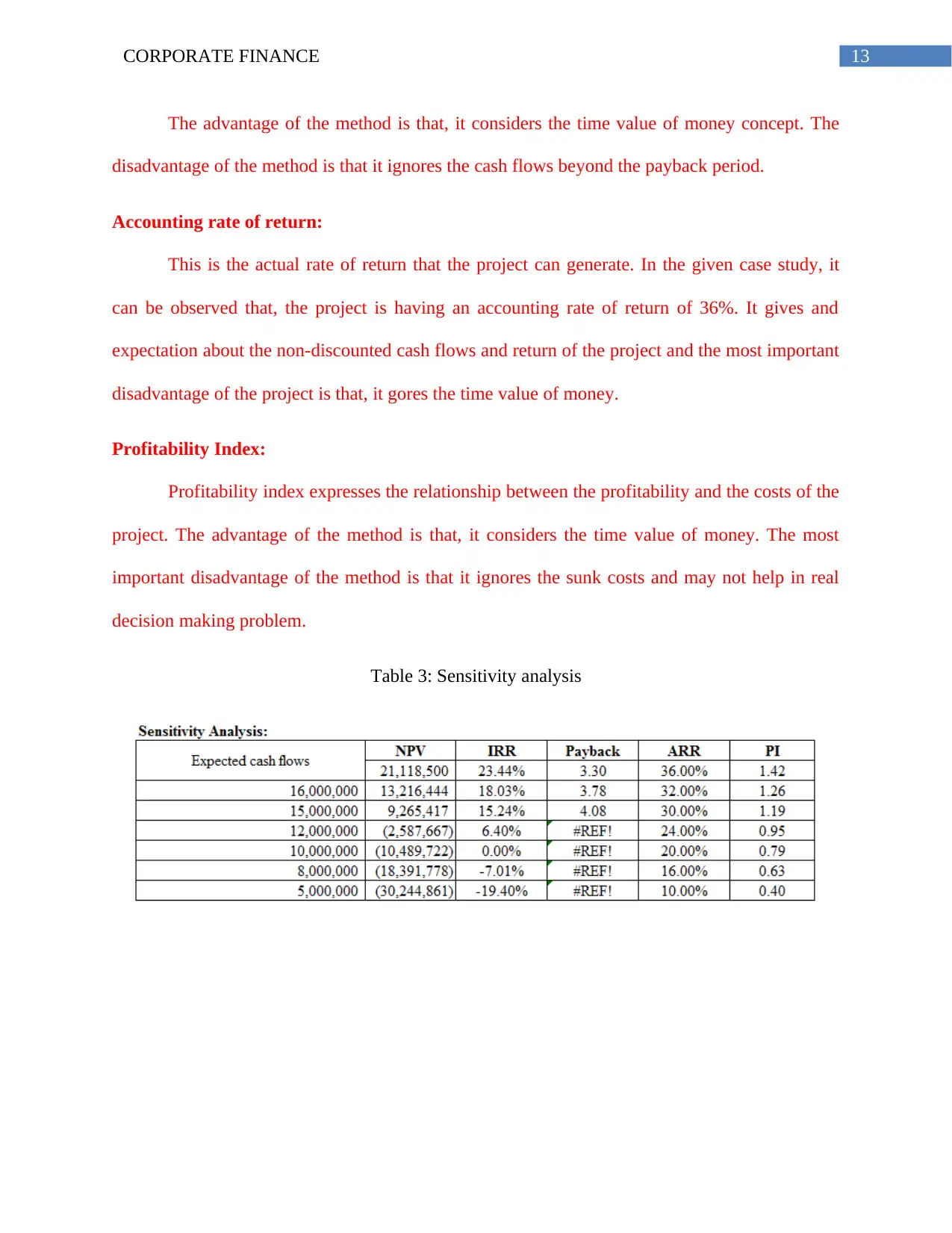
13CORPORATE FINANCE
The advantage of the method is that, it considers the time value of money concept. The
disadvantage of the method is that it ignores the cash flows beyond the payback period.
Accounting rate of return:
This is the actual rate of return that the project can generate. In the given case study, it
can be observed that, the project is having an accounting rate of return of 36%. It gives and
expectation about the non-discounted cash flows and return of the project and the most important
disadvantage of the project is that, it gores the time value of money.
Profitability Index:
Profitability index expresses the relationship between the profitability and the costs of the
project. The advantage of the method is that, it considers the time value of money. The most
important disadvantage of the method is that it ignores the sunk costs and may not help in real
decision making problem.
Table 3: Sensitivity analysis
The advantage of the method is that, it considers the time value of money concept. The
disadvantage of the method is that it ignores the cash flows beyond the payback period.
Accounting rate of return:
This is the actual rate of return that the project can generate. In the given case study, it
can be observed that, the project is having an accounting rate of return of 36%. It gives and
expectation about the non-discounted cash flows and return of the project and the most important
disadvantage of the project is that, it gores the time value of money.
Profitability Index:
Profitability index expresses the relationship between the profitability and the costs of the
project. The advantage of the method is that, it considers the time value of money. The most
important disadvantage of the method is that it ignores the sunk costs and may not help in real
decision making problem.
Table 3: Sensitivity analysis
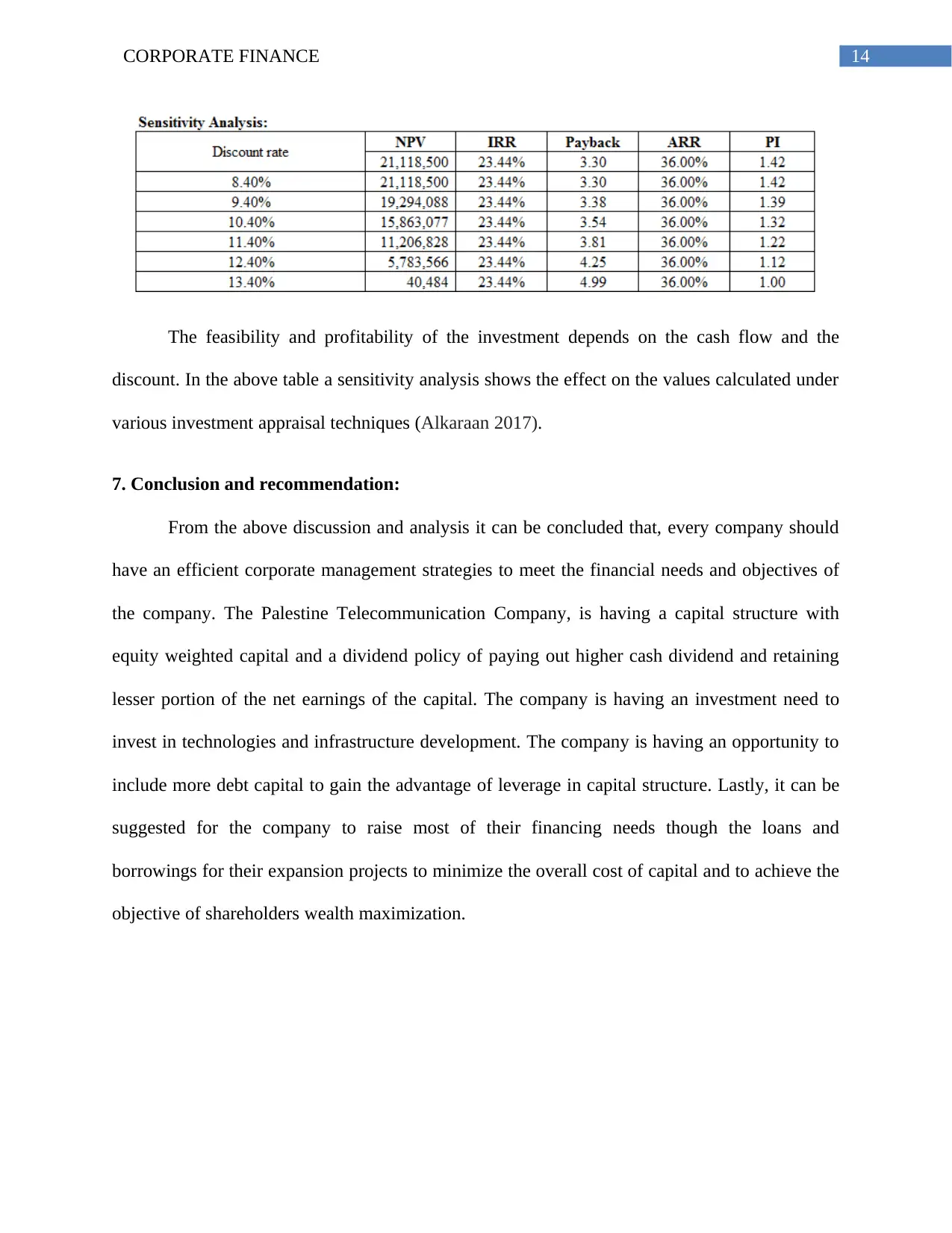
14CORPORATE FINANCE
The feasibility and profitability of the investment depends on the cash flow and the
discount. In the above table a sensitivity analysis shows the effect on the values calculated under
various investment appraisal techniques (Alkaraan 2017).
7. Conclusion and recommendation:
From the above discussion and analysis it can be concluded that, every company should
have an efficient corporate management strategies to meet the financial needs and objectives of
the company. The Palestine Telecommunication Company, is having a capital structure with
equity weighted capital and a dividend policy of paying out higher cash dividend and retaining
lesser portion of the net earnings of the capital. The company is having an investment need to
invest in technologies and infrastructure development. The company is having an opportunity to
include more debt capital to gain the advantage of leverage in capital structure. Lastly, it can be
suggested for the company to raise most of their financing needs though the loans and
borrowings for their expansion projects to minimize the overall cost of capital and to achieve the
objective of shareholders wealth maximization.
The feasibility and profitability of the investment depends on the cash flow and the
discount. In the above table a sensitivity analysis shows the effect on the values calculated under
various investment appraisal techniques (Alkaraan 2017).
7. Conclusion and recommendation:
From the above discussion and analysis it can be concluded that, every company should
have an efficient corporate management strategies to meet the financial needs and objectives of
the company. The Palestine Telecommunication Company, is having a capital structure with
equity weighted capital and a dividend policy of paying out higher cash dividend and retaining
lesser portion of the net earnings of the capital. The company is having an investment need to
invest in technologies and infrastructure development. The company is having an opportunity to
include more debt capital to gain the advantage of leverage in capital structure. Lastly, it can be
suggested for the company to raise most of their financing needs though the loans and
borrowings for their expansion projects to minimize the overall cost of capital and to achieve the
objective of shareholders wealth maximization.
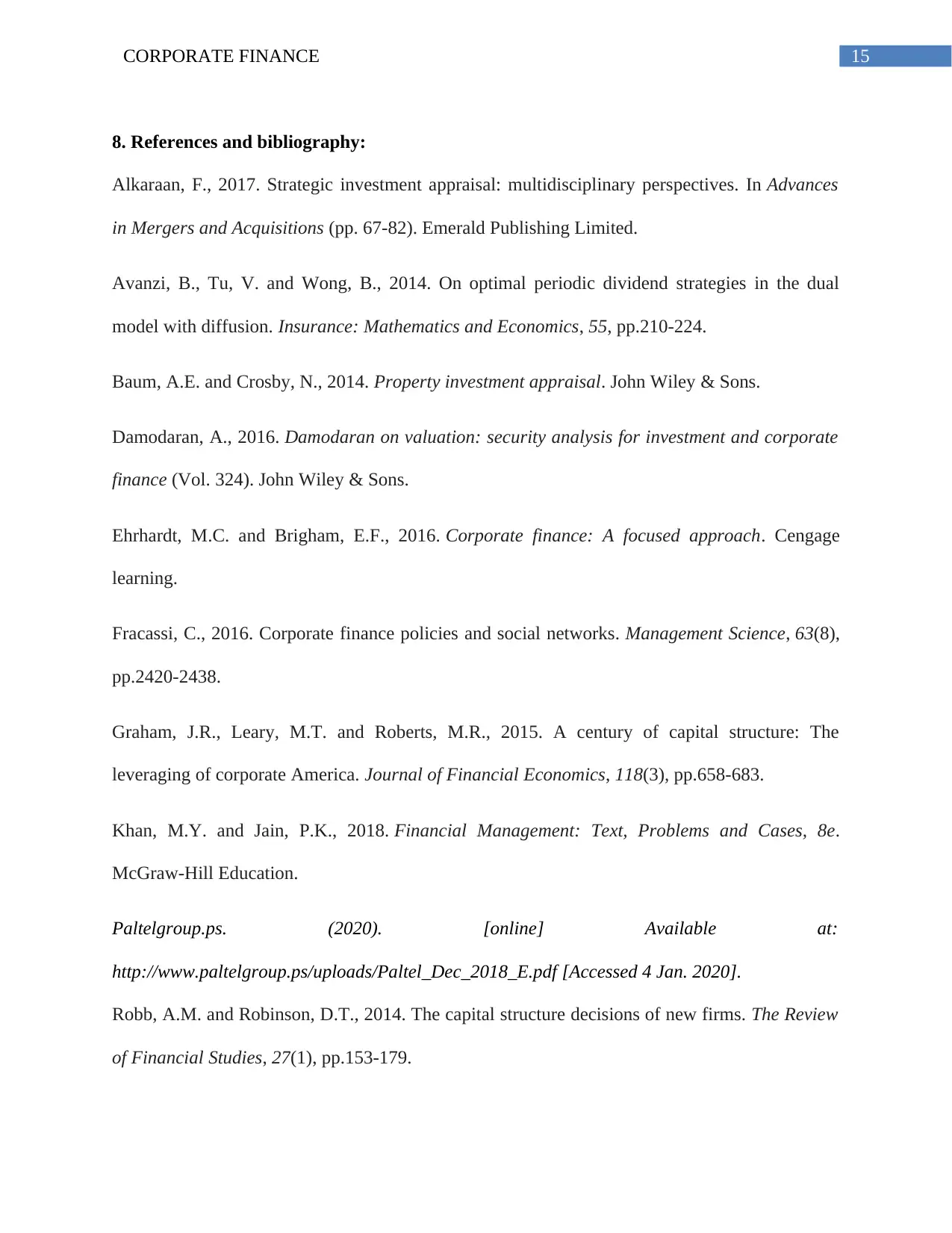
15CORPORATE FINANCE
8. References and bibliography:
Alkaraan, F., 2017. Strategic investment appraisal: multidisciplinary perspectives. In Advances
in Mergers and Acquisitions (pp. 67-82). Emerald Publishing Limited.
Avanzi, B., Tu, V. and Wong, B., 2014. On optimal periodic dividend strategies in the dual
model with diffusion. Insurance: Mathematics and Economics, 55, pp.210-224.
Baum, A.E. and Crosby, N., 2014. Property investment appraisal. John Wiley & Sons.
Damodaran, A., 2016. Damodaran on valuation: security analysis for investment and corporate
finance (Vol. 324). John Wiley & Sons.
Ehrhardt, M.C. and Brigham, E.F., 2016. Corporate finance: A focused approach. Cengage
learning.
Fracassi, C., 2016. Corporate finance policies and social networks. Management Science, 63(8),
pp.2420-2438.
Graham, J.R., Leary, M.T. and Roberts, M.R., 2015. A century of capital structure: The
leveraging of corporate America. Journal of Financial Economics, 118(3), pp.658-683.
Khan, M.Y. and Jain, P.K., 2018. Financial Management: Text, Problems and Cases, 8e.
McGraw-Hill Education.
Paltelgroup.ps. (2020). [online] Available at:
http://www.paltelgroup.ps/uploads/Paltel_Dec_2018_E.pdf [Accessed 4 Jan. 2020].
Robb, A.M. and Robinson, D.T., 2014. The capital structure decisions of new firms. The Review
of Financial Studies, 27(1), pp.153-179.
8. References and bibliography:
Alkaraan, F., 2017. Strategic investment appraisal: multidisciplinary perspectives. In Advances
in Mergers and Acquisitions (pp. 67-82). Emerald Publishing Limited.
Avanzi, B., Tu, V. and Wong, B., 2014. On optimal periodic dividend strategies in the dual
model with diffusion. Insurance: Mathematics and Economics, 55, pp.210-224.
Baum, A.E. and Crosby, N., 2014. Property investment appraisal. John Wiley & Sons.
Damodaran, A., 2016. Damodaran on valuation: security analysis for investment and corporate
finance (Vol. 324). John Wiley & Sons.
Ehrhardt, M.C. and Brigham, E.F., 2016. Corporate finance: A focused approach. Cengage
learning.
Fracassi, C., 2016. Corporate finance policies and social networks. Management Science, 63(8),
pp.2420-2438.
Graham, J.R., Leary, M.T. and Roberts, M.R., 2015. A century of capital structure: The
leveraging of corporate America. Journal of Financial Economics, 118(3), pp.658-683.
Khan, M.Y. and Jain, P.K., 2018. Financial Management: Text, Problems and Cases, 8e.
McGraw-Hill Education.
Paltelgroup.ps. (2020). [online] Available at:
http://www.paltelgroup.ps/uploads/Paltel_Dec_2018_E.pdf [Accessed 4 Jan. 2020].
Robb, A.M. and Robinson, D.T., 2014. The capital structure decisions of new firms. The Review
of Financial Studies, 27(1), pp.153-179.
Secure Best Marks with AI Grader
Need help grading? Try our AI Grader for instant feedback on your assignments.
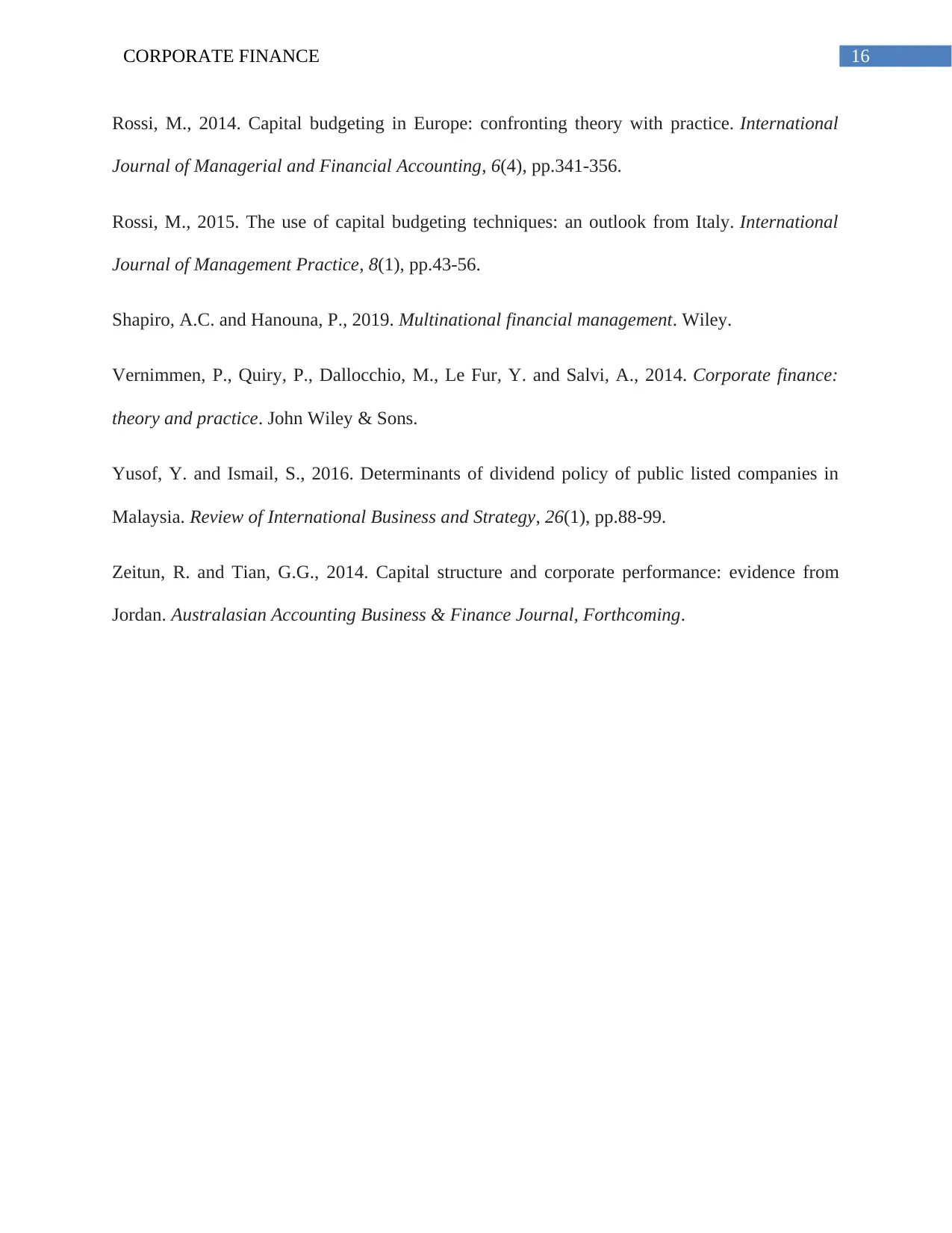
16CORPORATE FINANCE
Rossi, M., 2014. Capital budgeting in Europe: confronting theory with practice. International
Journal of Managerial and Financial Accounting, 6(4), pp.341-356.
Rossi, M., 2015. The use of capital budgeting techniques: an outlook from Italy. International
Journal of Management Practice, 8(1), pp.43-56.
Shapiro, A.C. and Hanouna, P., 2019. Multinational financial management. Wiley.
Vernimmen, P., Quiry, P., Dallocchio, M., Le Fur, Y. and Salvi, A., 2014. Corporate finance:
theory and practice. John Wiley & Sons.
Yusof, Y. and Ismail, S., 2016. Determinants of dividend policy of public listed companies in
Malaysia. Review of International Business and Strategy, 26(1), pp.88-99.
Zeitun, R. and Tian, G.G., 2014. Capital structure and corporate performance: evidence from
Jordan. Australasian Accounting Business & Finance Journal, Forthcoming.
Rossi, M., 2014. Capital budgeting in Europe: confronting theory with practice. International
Journal of Managerial and Financial Accounting, 6(4), pp.341-356.
Rossi, M., 2015. The use of capital budgeting techniques: an outlook from Italy. International
Journal of Management Practice, 8(1), pp.43-56.
Shapiro, A.C. and Hanouna, P., 2019. Multinational financial management. Wiley.
Vernimmen, P., Quiry, P., Dallocchio, M., Le Fur, Y. and Salvi, A., 2014. Corporate finance:
theory and practice. John Wiley & Sons.
Yusof, Y. and Ismail, S., 2016. Determinants of dividend policy of public listed companies in
Malaysia. Review of International Business and Strategy, 26(1), pp.88-99.
Zeitun, R. and Tian, G.G., 2014. Capital structure and corporate performance: evidence from
Jordan. Australasian Accounting Business & Finance Journal, Forthcoming.
1 out of 17
Related Documents
Your All-in-One AI-Powered Toolkit for Academic Success.
+13062052269
info@desklib.com
Available 24*7 on WhatsApp / Email
![[object Object]](/_next/static/media/star-bottom.7253800d.svg)
Unlock your academic potential
© 2024 | Zucol Services PVT LTD | All rights reserved.





